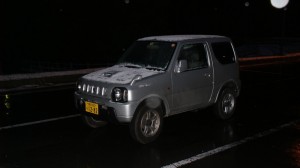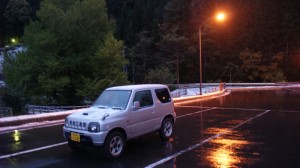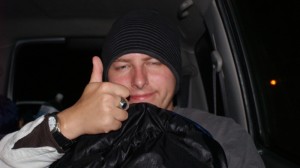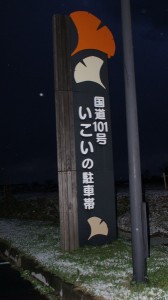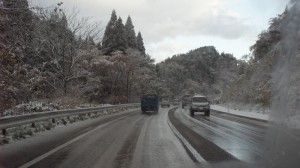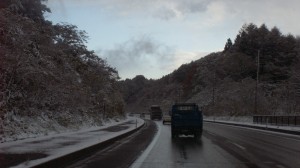How to survive Kei-Car camping
A ROUGH GUIDE ON WHAT TO DO WHEN YOU’RE STUCK.
PART. 1: DON’T PANIC!
DISCLAIMER: If you’re not the type to seek adventure, you’re not in Northern (or Cold) Japan, you hate cold, and you’re never lost as to your next options– chances are you’ll never use this guide… but what the heck, read it anyway.
I. The Scenario:
You had this great idea that with two vacation days coming up.. you’d jump in your Kei Jeep (A 2001 Suzuki Jimny) with a tent, a stove, two big sleeping bags, some water, and a change of clothes (oh and a camera) and head west to the other side of the prefecture to check it out. The idea is.. you’d find a camp site, setup your tent in a little chilly November weather, and camp while taking pictures of the Japan sea, the sunset, etc etc.
ok so far?
PART II. THE JOURNEY
So I took off Monday morning under a clear blue sky. The temp was “chilly” but nothing seriously cold. Overall it all looked good. The trek to the west side of the prefecture using local roads would take about 5 hours. Probably less for someone who knew where they were going or had a GPS with them.
Getting across the ken was pretty easy and somewhat enjoyable too. I really enjoy driving so cruising around small roads and through cities was awesome. Up to date the farthest west I’d been was Aomori City which is located in the middle of the prefecture. Past that point I could feel myself slowly getting lost, but nothing serious. I was rolling with a Mapple’s Map that I’d bought at the big Supermarket in town, but honestly I should of had a GPS…
As some points of reference I knew that the Western Main Road “Route 4” ran into “Route 7” which ran into a “Route 101.” Route 101 is the coastal route like in the Western US… it winds around the western side of the prefecture and eventually down into Akita Prefecture. On paper.. and on a map.. it makes perfect sense, however– once you drive it, everything just isn’t as it seems. Roads merge and change… you second guess yourself.. you make mistakes and get frustrated.
In a lost situation what I suggest is to find a road sign.. the intersection between X and Y. Stop on the side of road and flick on a turn blinker. Then check your map, Garmin GPS, or your cellphone map [like a GPS or triangulation phone map where your phone uses three or so cell towers to pin point your location] (of course if your phone does that stuff).
For me I got lost in a town called Goshyogawara. It’s a point where several roads intersect and it’s easy to get turned around. To get back on track I had to stop many times, check the map over and over, and proceed slowly– 90-100 yr. old speed.
Finally at one point I found the route out. It was like finding the final key in a Zelda quest– only now I would have to fight the next boss.
Part III. KEEPING AN OPEN MIND
Situations change as things are slowly introduced into the scene. Things like temperature, weather, and time.
I drove down 101 as it winded it’s way like a snake over a large mountain pass and eventually to the Japan sea. The pass was very cold with the temperature hovering around 0-2 degrees Celsius (like 32F-35F). As I drove it started to snow everywhere I went. It was pretty, but also ominous and not good for my prospects.
Having looked at the map over and over I decided I wanted to reach this place called “Shirokami Onsen.” On the map it just looked pretty neat, but that’s all I knew.
Along the route were some campsites that looked like I could stay the night at, but one by one I could see the the bathrooms were locked and the gates were closed. At one campside I had a foresight planning moment.
Foresight planning is often crucial as facts on the ground are different then you expected. What I mean by foresight planning is to consider the following:
- How Far and how many hours would it take to get home from where you are now.
- What do you think it’ll be like in 5, 7, and 10 hours from now?
- Is it raining? Snowing? Looking like it’s going to clear up or get worse?
- If not camping then what?
- What’s your fuel situation like? (If you’re at a half tank or below and it’s after 4 fill up now.)
- Finally, is there a grocery store, convenience store, or general market in the next 20km?
Once you’ve asked yourself some basic questions like that.. Start determining stuff and putting things into stone.
- If I don’t find a camping spot or figure out what I’m doing for the night by 8pm I’m driving home.
- If I drive home I’ll arrive at aprox. 12pm-1am.
- It’s getting colder so perhaps camping isn’t an option, I should look at a hotel perhaps or sleep in my car.
- My goals are going to this onsen (Shirokami) then moving on to the next thing.
Confidence was key to moving forward.
Most of all, bear-in-mind that you never think you’re getting into an extraordinary situation until 2-3am in the morning.
Reaching shirokami Onsen was good, however the place looked vacant. The lights were off and I couldn’t see anyone. At this point I was wavering on what to do.. I felt like leaving, but then I saw some lights come on… so I decided to go in.
Shirokami Onsen was really an Ofuro. Ofuro is the Japanese word for “Bath” except here, years ago and even today, ofuro was also the word for a “public bath house” where there’s a washing area then a ‘hot tub’ you sit in. Nothing about an Ofuro is supposed to be ‘glamorous’ but it is relaxing.
The cool part about Shirokami was that it was ran by two really old looking ladies. The spoke in an old lady Japanese accent which was tough to understand at first, but I could keep up. I asked if the ofuro was open and if I could use it.
I was the only one there too and I suppose, looking back on it, I could have asked to stay there for the night as there were tatami mat rooms. The old lady took me back to a room where the ofuro was. Typically I would pay first, but she didn’t care and told me I could pay later (if at all). The bath house was vacant.. Lights were off except for the hot tub that was going. Oddly in that moment I really was enjoying myself. No one there meant I could freely sit in that tub and relax without having to feel self concise about myself. I left an hour later and payed the lady and said good bye. I had spotted another onsen a few Km north that I wanted to go too as well.
The next onsen was called “Michi-no-o-ku” a common phrase in these parts taken from Matsuo Basho’s original book titled “Oku no hosomichi” A road to the interior. That onsen was also pretty night, but a bit crowded. I realized at this point that next time I do this I need to book a night here as it was a hotel/onsen combo. That would have made things easier.
Leaving Michi No Oku I could feel time pressing in… I decided at this point I needed to either camp in the car or split for home.
Part IV: FINDING THE RIGHT PARKING LOT
Finding a parking lot in Japan isn’t hard… there’s plenty. However, finding the right spot to stay over night is another story. I should stop here and say that spending a night in your car can be dangerous if you’ve never (I mean never ever) done it before. In fact, if it’s late and you’re tired, but you’ve never done this– pull over in a parking lot (leave the car on with the heater on) and take a short nap– then go to a combini and get an energy drink, then go home.
Ok now that that’s said.. I’ve slept in many of my cars in cold conditions too. I’ve learned some secrets that keep me safe and warm and I think they’re useful to share.
When you’re driving around to find a spot to ‘car-camp’ you gotta start no earlier then 9pm-10pm. Around this time you get a feel for what parked cars might also be there over night. The name of this game is to make your car look ordinary and something that supposed to be there.
Good spots (even in the US) to park are:
- Rest Stops (even Japanese have them)
- Big Store (un-monitored/un-patrolled) Parking lots
- Shopping mall parking lots
- (Sometimes) Public parks (if they look ok)
- Beach parking lots (that are elevated lol)
Things that make a good parking lot to camp in are one’s that have more then one full-time on lamp post, ones that have a public restroom, and ones where there’s some sort of “sheltered area” that’ll keep your car safe (i.e. don’t park with your front facing the Sea, instead park behind a building or some barrier or find another lot). Also the best lots might not be on your map! Drive around and keep in mind that finding “the right parking-lot” in Japan or in the US might take awhile. You might find a perfect lot and leave it to find a better one … or perhaps a perfect lot might not be perfect and you need to leave.
Once you’ve found a lot that looks suitable you’re going to need to find a good space. Survey the area and find spot that’s open, but not facing something like the ocean. Stay away from trees and if you can park 1 to 2 spaces left or right to a lamp post.
The next thing is to set up your car.
Often if you’re in a small Kei-car like I was you’ll need to sleep in the passenger seat. If you’re smart you will have brought two sleeping bags. The first bag lays out over the seat to cushion it and insulate it. If one bag is smaller then the other then the small bag goes down and your big bag goes on top. Set out things in the driver’s seat like water, your thick rain coat, a towel, and a flashlight or cellphone.
Also while setting up leave your car on. If you decided to car-camp early on you should have filled up at a gas station already and have plenty of gas. Turn on your heater to max and your blower to max. The idea is to get the cabin as warm as possible (perhaps even too warm). If it’s below freezing outside you’ll need to run your engine periodically.. I’ve never ran my engine the whole time.
So by now you should have set your passenger seat all the way back, have a sleeping bag down, a pillow (if you got one), and a second bag on top. The cabin should be warming up, and if you got ’em put on some loose sweat pants. This last part is personal choice. I slept in a car once in jeans and found jeans to keep me colder also I didn’t like it. Sweat pants are always more comfortable. Once you feel you got a grip on where you’ll be sleeping.. You’ll need to move into the “patrol hour.”
The patrol hour is something I do for 30min- 1 hour. The objective is to monitor your spot and the place around you to see if you’re ok being there. Here I watch for if a car pulls in to the parking lot, what it does, how long it sits there, if it drives off. You’re trying to get a feel for this area that you’ve never been in before. Call it ‘familiarizing yourself with you’re environment.’
For me, my environment was cold, but accessible. I found a public rest stop that looked like some construction was being done on it (this meant that it wasn’t abandon). I watched cars go in and leave until I was tired and eventually fell a sleep.
A note on sleeping. When you car-camp it’s not like you’re at a motel 8. You’ll be sleeping in periods of 30 min to 2 hours at a time at the most. Every sound, every heavy rain fall, or every wind gust might wake you up. It’s important when you wake up you assess yourself in the following: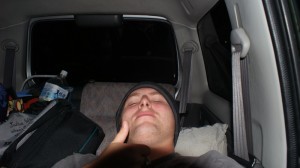
- What parts of me are cold?
- Should I put on my insulated rain coat (the answer to this, as soon at you think of this question, is always yes)
- Do I need to run my car heater? For how long? (If it’s cold with your sleeping bag on then yes, turn it on till it’s not cold with your sleeping bag over.
- What time is it, who is in the parking lot with me, and how long till sun rise.
Last night I pretty much woke up every hour, and once after two hours. Every time I woke up I drank some water and did my check list. It was cold and lots of things woke me up.. Snow, Wind, A hail storm, other cars… It was rough.
Eventually after a tough night I woke up finally at 5:30am. I could see the sun going up so I took down my bedding and readjusted my car and hit the can for the last time. Afterwards I drove to a McDonalds then back home where I took a real nap and made tacos for dinner.
The drive home was spectacular. Apparently it snowed all over the prefecture last night.
The roads were snowed over and everything looked like a winter wonderland! Mind you it’s only November 3rd in this picture…
Overall, you need to be smart about every choice you make. Survival boils down to a very very simple question: “How comfortable can I make myself with what I got.” Survival experts way smarter then me spend hours in their camp making tools to do what? Make it more comfortable for themselves.
Car-camping can be fun… it can be easy too.. but be smart about it.. if it’s your first time do it in a controlled environment (i.e. at your home or something).
That’s all I got for this guide.. (though I might add some Japan specific things later)
~J out

